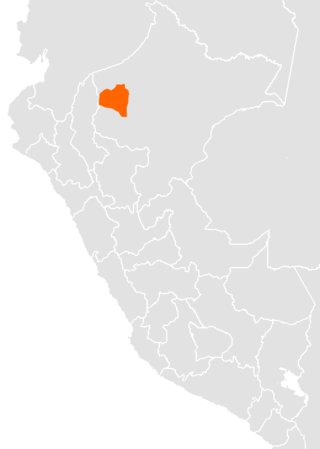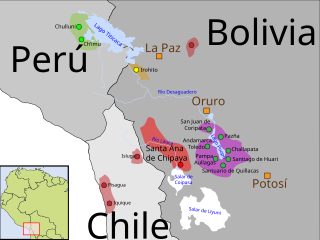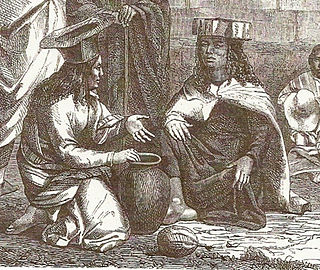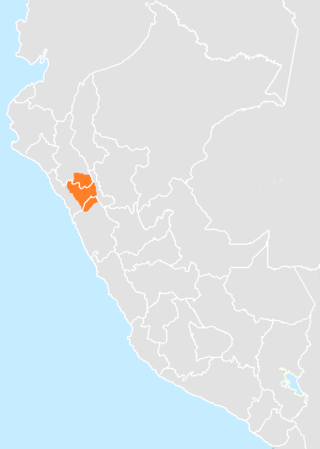Related Research Articles

Quechua, also called Runasimi in Southern Quechua, is an indigenous language family that originated in central Peru and thereafter spread to other countries of the Andes. Derived from a common ancestral "Proto-Quechua" language, it is today the most widely spoken pre-Columbian language family of the Americas, with the number of speakers estimated at 8–10 million speakers in 2004, and just under 7 million from the most recent census data available up to 2011. Approximately 13.9% of Peruvians speak a Quechua language.

Aymaran is one of the two dominant language families in the central Andes alongside Quechuan. The family consists of Aymara, widely spoken in Bolivia, and the endangered Jaqaru and Kawki languages of Peru.
Paezan may be any of several hypothetical or obsolete language-family proposals of Colombia and Ecuador named after the Paez language.
The Araucanian languages are a small language family of indigenous languages of the Americas spoken in central Chile and neighboring areas of Argentina. The living representatives of this family are Mapudungun and Huilliche, spoken respectively by the Mapuche and Huilliche people. These are usually considered divergent dialects of a single language isolate.

Munichi is a recently extinct language which was spoken in the village of Munichis, about 10 miles (16 km) west of Yurimaguas, Loreto Region, Peru. In 1988, there were two mother-tongue speakers, but they had not met since the 1970s. The last known fluent speaker, Victoria Huancho Icahuate, died in the late 1990s. As of 2009 there were several semi-speakers who retained significant lexical, and partial grammatical, knowledge of the language.

Tacanan is a family of languages spoken in Bolivia, with Ese’ejja also spoken in Peru. It may be related to the Panoan languages. Many of the languages are endangered.

Puquina is a small, putative language family, often portrayed as a language isolate, which consists of the extinct Puquina language and Kallawaya, although it is assumed that the latter is just a remnant of the former mixed with Quechuan. Puquina speakers are last mentioned in the early nineteenth century.
Yuracaré is an endangered language isolate of central Bolivia in Cochabamba and Beni departments spoken by the Yuracaré people.
The Cahuapanan languages are a language family spoken in the Amazon basin of northern Peru. They include two languages, Chayahuita and Jebero, which are spoken by more than 11,300 people. Chayahuita is spoken by most of that number, but Jebero is almost extinct.
Itonama is a moribund or extinct language isolate once spoken by the Itonama people in the Amazonian lowlands of north-eastern Bolivia. It was spoken on the Itonomas River and Lake in Beni Department.

Spanish is the de facto official and administrative language of Chile. It is spoken by 99.3% of the population in the form of Chilean Spanish, as well as Andean Spanish. Spanish in Chile is also referred to as "castellano". Although an officially recognized Hispanic language does not exist at the governmental level, the Constitution itself, as well as all official documents, are written in this language.

Candoshi-Shapra is an indigenous American language isolate, spoken by several thousand people in western South America along the Chapuli, Huitoyacu, Pastaza, and Morona river valleys. There are two dialects, Chapara and Kandoashi (Kandozi). It is an official language of Peru, like other native languages in the areas in which they are spoken and are the predominant language in use. Around 88.5 percent of the speakers are bilingual with Spanish. The literacy rate in Candoshi-Shapra is 10 to 30 percent and 15 to 25 percent in the second language Spanish. There is a Candoshi-Shapra dictionary, and grammar rules have been codified.
Arutani is a nearly extinct language spoken in Roraima, Brazil and in the Karum River area of Bolivar State, Venezuela. There are only around 6 speakers left.

The Uru–Chipaya family is an indigenous language family of Bolivia.

The Atacama people, also called Atacameño, are an Indigenous people from the Atacama Desert and altiplano region in the north of Chile and Argentina and southern Bolivia, mainly the Antofagasta Region.

Culle, also spelled Culli, Cullí, or Kulyi, is a poorly attested extinct language of the Andean highlands of northern Peru. It is the original language of the highlands of La Libertad Region, the south of the Cajamarca Region (Cajabamba), and the north of the Ancash region. It is known through various word lists collected while the language was still spoken and through vocabulary loaned into the Spanish spoken in the region.

Harakmbut or Harakmbet is the native language of the Harakmbut people of Peru. It is spoken along the Madre de Dios and Colorado Rivers, in the pre-contact country of the people. There are two dialects that remain vital: Amarakaeri (Arakmbut) and Watipaeri (Huachipaeri), which are reported to be mutually intelligible. The relationship between speakers of the two dialects is hostile.
The Intercontinental Dictionary Series is a large database of topical vocabulary lists in various world languages. The general editor of the database is Bernard Comrie of the Max Planck Institute for Evolutionary Anthropology, Leipzig. Mary Ritchie Key of the University of California, Irvine is the founding editor. The database has an especially large selection of indigenous South American languages and Northeast Caucasian languages.
Chimané (Tsimané) is a South American language isolate. Some dialects are known as Mosetén. Chimane is a language of the western Bolivian lowlands spoken by the Tsimane peoples along the Beni River and the region around San Borja in the Department of Beni (Bolivia). Sakel (2004) classifies them as two languages for a number of reasons, yet some of the variants of the language are mutually intelligible and they reportedly have no trouble communicating and were evidently a single language separated recently through cultural contact.
References
- ↑ Jolkesky, Marcelo Pinho de Valhery (2016). Estudo arqueo-ecolinguístico das terras tropicais sul-americanas (Ph.D. dissertation) (2 ed.). Brasília: University of Brasília.
- 1 2 Adelaar, Willem; Muysken, Pieter (2004). The Languages of the Andes. New York: Cambridge University Press. p. 380.